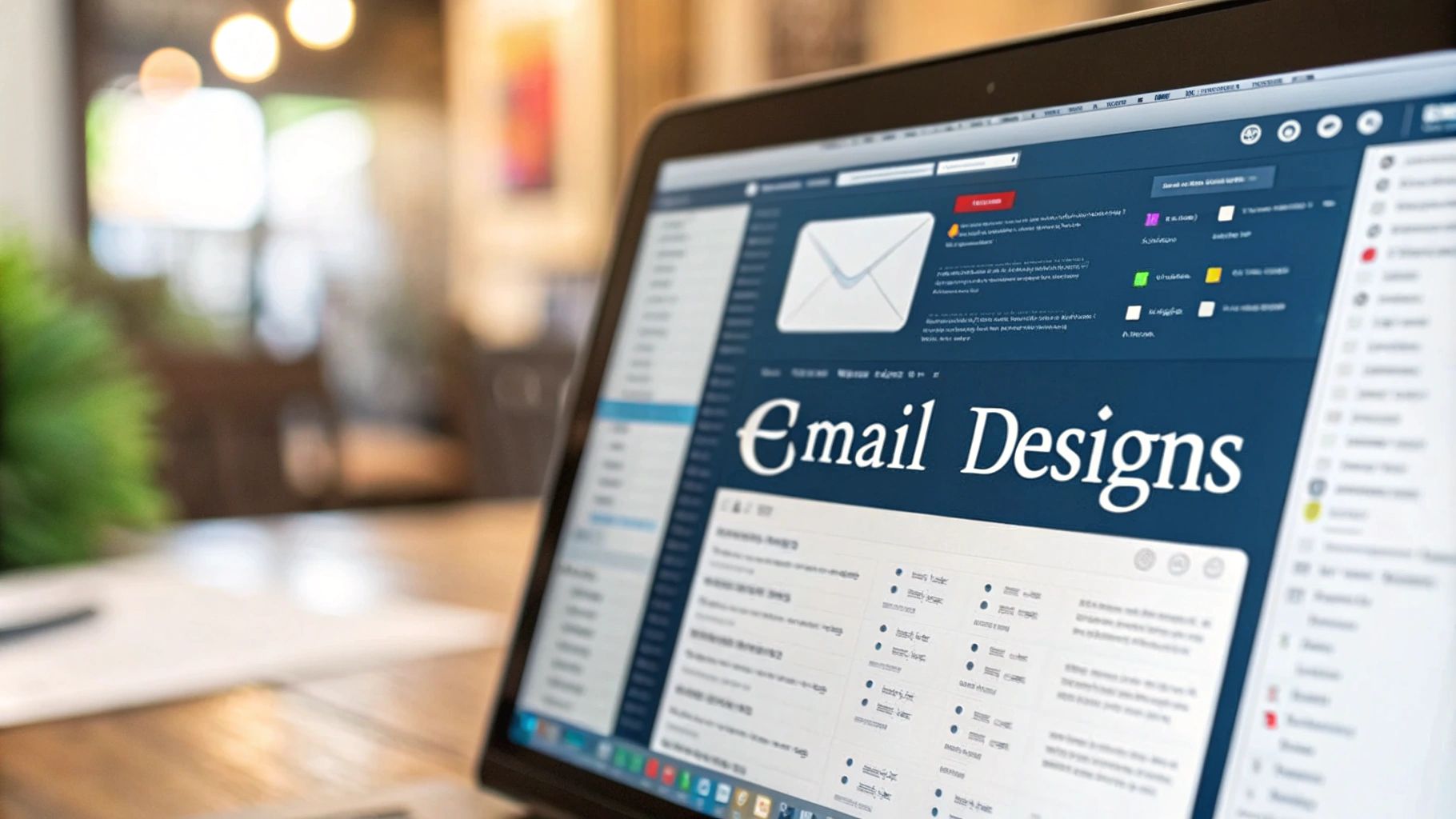15 Powerful Email Marketing Campaign Ideas That Drive Real Results
The Evolution and Impact of Modern Email Campaigns

Email marketing continues to deliver outstanding results compared to other digital channels. Consider this: email generates $42 for every dollar spent – a 4200% return on investment. In comparison, social media brings in just $2.80 per dollar invested. This impressive performance comes from email's growth into a highly personalized communication tool that connects with audiences in meaningful ways.
From Mass Messaging to Meaningful Connections: The Rise of Personalization
The early days of email marketing relied heavily on sending the same message to everyone. Today's consumers expect more – they want messages that speak directly to their interests and needs. For example, when a clothing retailer sends you product recommendations based on what you've browsed and bought before, it creates a much more engaging experience than a generic promotion blast. The numbers back this up: personalized emails are six times more likely to drive sales, and 88% of people say they appreciate emails that feel personally crafted for them.
Beyond First Names: Dynamic Content and Segmentation for Deeper Engagement
Modern personalization means more than just adding someone's name to an email. It's about creating content that changes based on each person's specific data and behaviors. This happens through careful audience segmentation – grouping people by their shared traits and actions. Think of a bookstore – they wouldn't send the same email to mystery fans and science fiction readers. By splitting their list into specific reader groups, they can send targeted book recommendations that people actually want to see. This approach works: businesses that segment their email lists see their revenue grow by 760% on average.
Mobile Optimization: Reaching Your Audience Where They Are
Over one-third of all emails are opened on phones and tablets, making mobile-friendly design essential. If an email doesn't look good on mobile, half of recipients will delete it without reading – that's like throwing away half your audience. Good mobile emails need clear, tappable buttons, fast loading times, and content that's easy to read on small screens. With 88% of people checking email multiple times daily on their phones (39% checking 3-5 times), getting the timing and frequency right becomes crucial. Success comes from understanding when your audience checks their email and how often they want to hear from you.
Crafting Personalization That Actually Converts
Adding someone's first name to an email just doesn't cut it anymore. Customers can spot generic personalization from a mile away and expect brands to really understand who they are and what they care about. The key is using customer data thoughtfully to create messages that feel authentic and relevant.
Segmenting Your Audience for Targeted Messaging
The first step in meaningful personalization is dividing your audience into specific groups. Think about it – sending the exact same email about running shoes to both serious runners and casual yoga fans makes no sense. Instead, break down your list based on what people have bought before, which emails they open, and how they interact with your brand. This lets you craft messages that really click with each group. A marathon runner gets details on performance shoes, while a yogi sees the latest in comfortable workout wear. The numbers back this up – targeted emails can boost revenue by up to 760%.
Developing Dynamic Content That Adapts to the Individual
Once you've got your segments set up, you can create emails that automatically adjust their content for each reader. This goes way beyond just dropping in someone's name – we're talking about swapping out images, product suggestions, and call-to-action buttons based on what you know about that person. It's like having a conversation where you remember everything about the customer and use those details to show them exactly what they're most interested in seeing.
Implementing Manageable Personalization Strategies
Getting started with personalization doesn't have to be complicated. Most email platforms come with built-in tools that make it easy to segment your list and create flexible content, even if you're not a coding expert. The key is starting small – maybe begin by customizing your welcome emails based on how people signed up. For example, if someone joins through a Facebook ad about summer dresses, send them a special discount on warm-weather styles. As you get comfortable, you can gradually add more personalized touches.
Real-World Examples of Personalization Success
Some brands are already showing how powerful smart personalization can be. Music streaming services send weekly playlist recommendations based on what each person likes to listen to, keeping subscribers engaged and coming back for more. Online stores follow up on abandoned shopping carts by reminding customers about specific items they left behind and suggesting similar products they might like. These aren't just nice touches – email campaigns with this level of personalization regularly see returns of 4200% on investment. When you transform generic email blasts into carefully tailored messages, you build stronger customer relationships that drive real business results.
Building Mobile-First Campaigns That Engage
Having your emails work well on mobile devices isn't optional anymore – it's essential for success. More than one-third of all emails are now opened on phones and tablets. When an email doesn't display properly on mobile, many readers will simply delete it without a second thought. Picture spending hours crafting the perfect email, only to have it show up as a jumbled mess on your subscribers' phones. That lost connection with your audience defeats the whole purpose of your campaign.
Designing for Thumbs: The Importance of Mobile-Friendly Layouts
The way people use their phones should guide how we design emails. Most people scroll and tap with their thumbs, so we need to make that experience smooth and natural. This means using bigger buttons that are easy to tap, keeping text brief and scannable, and organizing content so the most important parts stand out right away. Think of it like a highway billboard – you need to get your message across quickly and clearly. Make sure readers can find what they need without pinching to zoom or endless scrolling. For text that's comfortable to read, stick to at least 16px font size in the main body.
Optimizing Loading Times for On-the-Go Readers
Nobody likes waiting for slow emails to load, especially on mobile networks. Even a few seconds of delay can prompt readers to give up and move on. To keep loading quick, compress your images properly, stick to standard web fonts, and keep your code clean. It's like packing for a trip – only bring what you really need. Big image files and unnecessary code just slow things down, so trim away anything that isn't essential for getting your message across.
Testing Across Devices: Ensuring Consistent Performance
Your email needs to work smoothly no matter what device someone uses to read it. Different phones and email apps can display the same email in surprisingly different ways. The only way to catch these issues is to test thoroughly across various devices – check how it looks on different iPhones and Android phones, tablets, and desktop computers. A broken link or misaligned image can really hurt your campaign's impact. Regular testing helps you spot and fix problems before they reach your audience, ensuring everyone gets the experience you intended. When your emails work well everywhere, readers are more likely to engage with your content and take action.
Automation Strategies That Drive Revenue Growth
Gone are the days of basic welcome emails. Smart marketers now use automation to create email campaigns that connect with customers and boost sales. By moving beyond simple drip campaigns, businesses can build responsive workflows that deliver results.
Automated Email Sequences for Enhanced Engagement
Email sequences help nurture relationships with potential customers. For example, when someone downloads a resource from your website, an automated series of emails can provide helpful information, share relevant case studies, and guide them toward making a purchase. This steady communication builds trust and increases the chances they'll buy. Win-back campaigns work similarly – they can re-engage inactive subscribers by offering special discounts or showing new product features. These targeted sequences make emails feel personal while driving more engagement.
Abandoned Cart Recovery: Recapturing Lost Sales
Cart abandonment is a major challenge, with around 70% of online shoppers leaving items behind. Automated emails can help recover these potential sales. When a customer adds products to their cart but doesn't complete the purchase, a well-timed email reminds them what they left behind. Adding a small incentive like free shipping can give them the final push to buy. This simple follow-up turns abandoned carts into completed orders by reconnecting with interested customers at just the right moment.
Maintaining Customer Relationships at Scale
While one-on-one interaction is great, it's not realistic for companies with thousands of customers. Automated emails let you stay in touch personally, even with a large subscriber base. After someone makes a purchase, you can automatically send helpful tips about their product, ask for feedback, and suggest related items they might like. This regular contact keeps customers engaged and coming back to buy again.
Testing, Optimizing, and Scaling Your Automation
For automated emails to work well, you need to test and improve them over time. Try different subject lines, email content, and buttons to see what gets the best response. Keep track of important numbers like open rates, click rates, and sales to understand what's working. This data helps you make your campaigns better and better. As your business grows, these proven email workflows can handle more customers while keeping communications personal and sales strong. The key is to keep testing and refining to turn basic automated messages into powerful tools for engagement and revenue.
Mastering Email Frequency and Timing
Getting email frequency right is one of the most important parts of running successful email campaigns. Send too many emails and you risk annoying subscribers. Send too few and you might miss opportunities to engage. Finding that sweet spot takes careful planning and continuous refinement.
Finding Your Rhythm: Establishing a Baseline Sending Frequency
Every industry has different norms when it comes to email frequency. A flash sale site might email customers multiple times per day about new deals. Meanwhile, a software company might stick to weekly product updates or monthly newsletters. Look at what similar companies in your space are doing as a starting point, but don't just copy them. Consider your specific audience and goals when setting your initial schedule.
The Power of Segmentation: Tailoring Frequency to Subscriber Groups
Your subscribers aren't all the same, so your email frequency shouldn't be either. Break your list into groups based on how people interact with your emails. For example, your most engaged subscribers who regularly open and click might welcome more frequent touches. New subscribers could start with daily welcome emails that gradually decrease to weekly sends. This way, each group gets communication at a pace that works for them.
Testing and Refining: The Key to Optimization
The only way to truly optimize your sending frequency is through testing. Try different schedules with small segments of your list. Watch your open rates, click rates, and unsubscribe numbers closely. You might find that sending twice a week drives much better results than weekly emails. Or the opposite could be true. The data will tell you what's working best for your specific audience.
Timing is Everything: Optimizing Your Send Times
When you send matters just as much as how often. Test different days and times to see when your subscribers are most likely to engage. Think about your audience's typical schedule and time zones. Many email platforms can show you when people tend to open your messages. But don't set it and forget it – optimal timing can shift as your audience's habits change. Keep testing and adjusting based on the results you see.
Scaling Success: Metrics That Drive Growth
Email marketing success requires more than just creative campaigns – you need solid measurement to understand what's working and drive better results. Rather than focusing only on basic metrics like open rates, smart marketers track data that reveals the real impact of their email efforts. By measuring the right things, you can make informed decisions to improve your campaigns and grow your email program.
Key Performance Indicators (KPIs) Beyond the Basics
While open rates provide some insight, they don't tell the whole story. A catchy subject line might get someone to open your email, but what matters is what they do next. Click-through rate (CTR) shows how many people actually clicked links in your email – a much better indicator of genuine interest. For instance, if recipients click through to view a product, they're more likely to make a purchase. Conversion rate takes it a step further by measuring how many clicks lead to actual sales or sign-ups, connecting your emails directly to business results.
Building a Measurement Framework for Email Marketing Campaigns
Good measurement looks at the complete customer journey, not just individual metrics. Start by setting clear goals for each campaign – do you want to drive sales, build brand awareness, or bring back inactive subscribers? Once you know your objectives, pick the metrics that best show progress toward those goals. Think long-term too – track things like customer lifetime value and how many subscribers stop engaging over time. This helps you understand both immediate campaign performance and lasting impact on customer relationships.
Testing and Optimization for Continuous Improvement
Success requires ongoing testing and refinement based on data. Try A/B testing different elements like subject lines, email content, and call-to-action buttons to see what resonates with your audience. For example, test two subject line versions to find which one gets more opens, then apply those learnings to future campaigns. Look at how different customer segments respond too – this can help you create more relevant, targeted messages.
From Data to Actionable Insights
Having data is just the start – you need to turn those numbers into real improvements. Look for patterns in your metrics to make smart choices about how often to send emails, when to send them, and what content to include. Don't just note what the numbers show, but understand why they changed. If conversions suddenly drop, maybe there's an issue with your checkout process that needs fixing. Regular analysis helps transform your email marketing from scattered campaigns into a reliable driver of business growth.
Ready to take your website and business to the next level? Visit DebugBar.com for helpful tech news, marketing tips, software reviews and practical guides that will help your business succeed.



Comments
Leave a comment